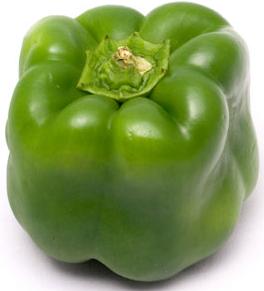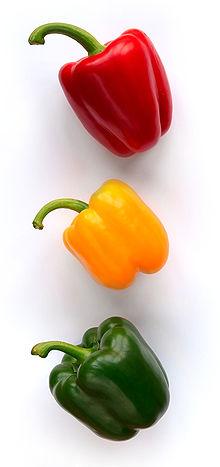Green Peppers
Green Peppers are unripe peppers, while the other colors of peppers are all ripe. Since green peppers are unripe, they are less sweet and slightly more bitter than yellow, orange, or red peppers. The botanical name for green peppers is Capsicum annum.
 The taste of ripe peppers can vary with growing conditions and post-harvest storage treatment; the sweetest peppers are the ones allowed to ripen fully on the plant in full sunshine, while fruit harvested green and after-ripened in storage are less sweet.
The taste of ripe peppers can vary with growing conditions and post-harvest storage treatment; the sweetest peppers are the ones allowed to ripen fully on the plant in full sunshine, while fruit harvested green and after-ripened in storage are less sweet.
Red peppers have more vitamins and nutrients and contain the antioxidant lycopene, than green peppers. The level of carotene, another antioxidant, is nine times higher in red peppers than green peppers. Red peppers also have twice the vitamin C content of green peppers.
The pepper is a warm-season vegetable. Pepper plants require higher temperatures and grow slower and the plants are smaller than most tomato plants.
Bell peppers are available in many colors–green, red, yellow, and even orange. The color depends on the variety and the stage of ripeness. Most are sold as a mature bell pepper-green, fully developed but not ripe. Ripened on the vine, they turn redder and sweeter and have the highest amount of vitamins A and C. Maine-grown bell peppers are available from August to October.
Bell peppers are an excellent source of vitamins A and C. One raw pepper provides more vitamin C than one cup of orange juice. Because cooking can destroy some vitamin C, you will get the most benefit from peppers if you eat them raw.
When buying peppers make sure peppers have good color and a glossy surface. Peppers should be firm and feel heavy for their size.
Storage for Green Peppers
 Green peppers should be stored in the refrigerator. Green peppers can be stored in a plastic bag, loosely tied or knotted: make sure peppers are dry before storing. Green peppers can be stored in the refrigerator for up to 2 weeks.
Green peppers should be stored in the refrigerator. Green peppers can be stored in a plastic bag, loosely tied or knotted: make sure peppers are dry before storing. Green peppers can be stored in the refrigerator for up to 2 weeks.
Uses and Tips for Green Peppers
Green peppers can be eaten raw or cooked. Raw green peppers can be eaten plain as a snack or an appetizer, and sliced or chopped to add to salads. Slice green peppers into sticks and dip in low-fat dressing or other low-fat dip. Green peppers can be cooked using many different methods, and are often added to dishes like stir-fries, casseroles, omelets, soups, and stews. Since they are firm on the outside, green peppers can be “stuffed” with fillings including ground meat or turkey, then oven-baked. Sauteed peppers and onions are delicious on sub sandwiches.
Preparation/Cooking for Green Peppers
Once washed, remove stem, seeds, and pulpy part before eating raw or cooking.
To boil: Cut peppers into pieces. Add to boiling water, reduce heat and cook for about 5 minutes, depending on the size of the pieces.
To bake or roast: Cut peppers into pieces. Place on a baking sheet coated with cooking spray and bake or roast at 400 degrees F for 30 minutes or until peppers are browned and soft.
To microwave: Cut pepper into slices and place in a microwave-safe dish. Cover and cook on high for 3 minutes. Stir once through cooking time.
Nutrition Information for Green Peppers
½ cup of raw, chopped, or cooked green peppers counts as ½ cup in the MyPyramid.gov Vegetable Group.
For a 2,000-calorie diet, the daily recommendation is about 2 ½ cups of vegetables. ½ cup of green peppers provides 100% of the daily recommended amount of vitamin C.
Food Safety Information for Green Peppers
Keep green peppers away raw meat, poultry, or seafood and from the kitchen tools used with the meat, poultry, or seafood. Rinse green peppers well before eating fresh or cooking.
| Total Fat 0g | 0% |
| Saturated Fat 0g | 0% |
| Total Fat 0g | |
| Cholesterol 0mg | 0% |
| Sodium 0mg | 0% |
| Total Carbohydrate 3g | 1% |
| Dietary Fiber 1g | 4% |
| Sugars 2g | |
| Protein 1g | |
| Vitamin A 6% | Vitamin C 100% |
| Calcium 0% | Iron 2% |
| *% Daily Values are based on a 2,000 calorie diet. | |
Stuffed Vegetarian Green Peppers
This low-fat recipe is an excellent source of vitamin C, and is rich in vitamin A, iron and calcium. Note: you can use any color of peppers you desire - not limited to green peppers. Serves: 6
- 6 medium to large green peppers
- 1 chopped onion
- 1 diced clove garlic
- 2 tablespoons chopped parsley
- 1 cup uncooked rice, brown or white (cook per pkg directions)
- 1 cup of kidney beans (optional)
- 1 pkg of crumbles (fake meat)
- 1 jar of your favorite spaghetti sauce
Preparing stuffed green, red or yellow peppers
- Remove top and seeds from green peppers
- To make filling, saute onion and garlic in oil
- Add cooked rice, crumbles, beans, parsley, and 1 cup spaghetti sauce
- Place green peppers in a large pot and add water until half the peppers are covered. (to keep peppers from falling over - insert potatoes between peppers).
- Use the rest of spaghetti sauce to serve over peppers when eating.
- Boil peppers for 30-minutes. Peppers should be soft when inserting knife.
- You can also Bake at 350 degrees F for 20 to 30 minutes, adding some water to the pan and covering top with spaghetti sauce. I prefer to boil my stuffed peppers.

